2022 Jeep Wagoneer Review: A New Twist on a Classic
Jeep enters the full-size SUV fray with the premium-priced 2022 Wagoneer.
Capital One
Jeep has revived its celebrated Wagoneer model three decades after discontinuing its woodgrain-sided predecessor. The new 2022 Wagoneer (and its even more luxurious sibling, the Grand Wagoneer) resides at the top of Jeep’s lineup in size, luxury, technology, and price. As such, the full-size, eight-seat Wagoneer is the company’s new flagship SUV, pushing the slightly smaller, three-row Grand Cherokee L into the second position.
Historically, the Jeep Wagoneer nameplate has represented competency and ruggedness. The original model supplied superior off-road capabilities aligned with the rest of the Jeep lineup, but in a much larger package.
Customers liked that the Wagoneer was more advanced than its competitors, with innovative engines, better transmissions, more power equipment (such as power steering), and amenities that set it apart. Wagoneer owners appreciated the model’s jack-of-all-trades competency—utility with conveniences—and popularity ensued.
 Michael Harley
Michael Harley
Industry experts credit the original Jeep Wagoneer with helping to spark today’s SUV boom. And now, Jeep aims to recapture some of the original’s magic in the all-new 2022 Wagoneer.
Jeep says the Wagoneer “marks the rebirth of a premium American icon” and is the “new standard of sophistication, authenticity, and modern mobility.” Of course, those are lofty roles to fulfill, but based on a week spent driving the 2022 Wagoneer, Jeep has done an exemplary job targeting a more affluent audience and ensuring that the revived nameplate lives up to those promises.
For this 2022 Jeep Wagoneer review, I test-drove a Series III model in Los Angeles. It came with optional 22-inch wheels, the Premium Group package, the Rear-Seat Entertainment Group package, and the Heavy-Duty Trailer-Tow package, extras that inflated the sticker price to $86,325, including the $2,000 destination charge. Jeep provided the vehicle for this Wagoneer review.
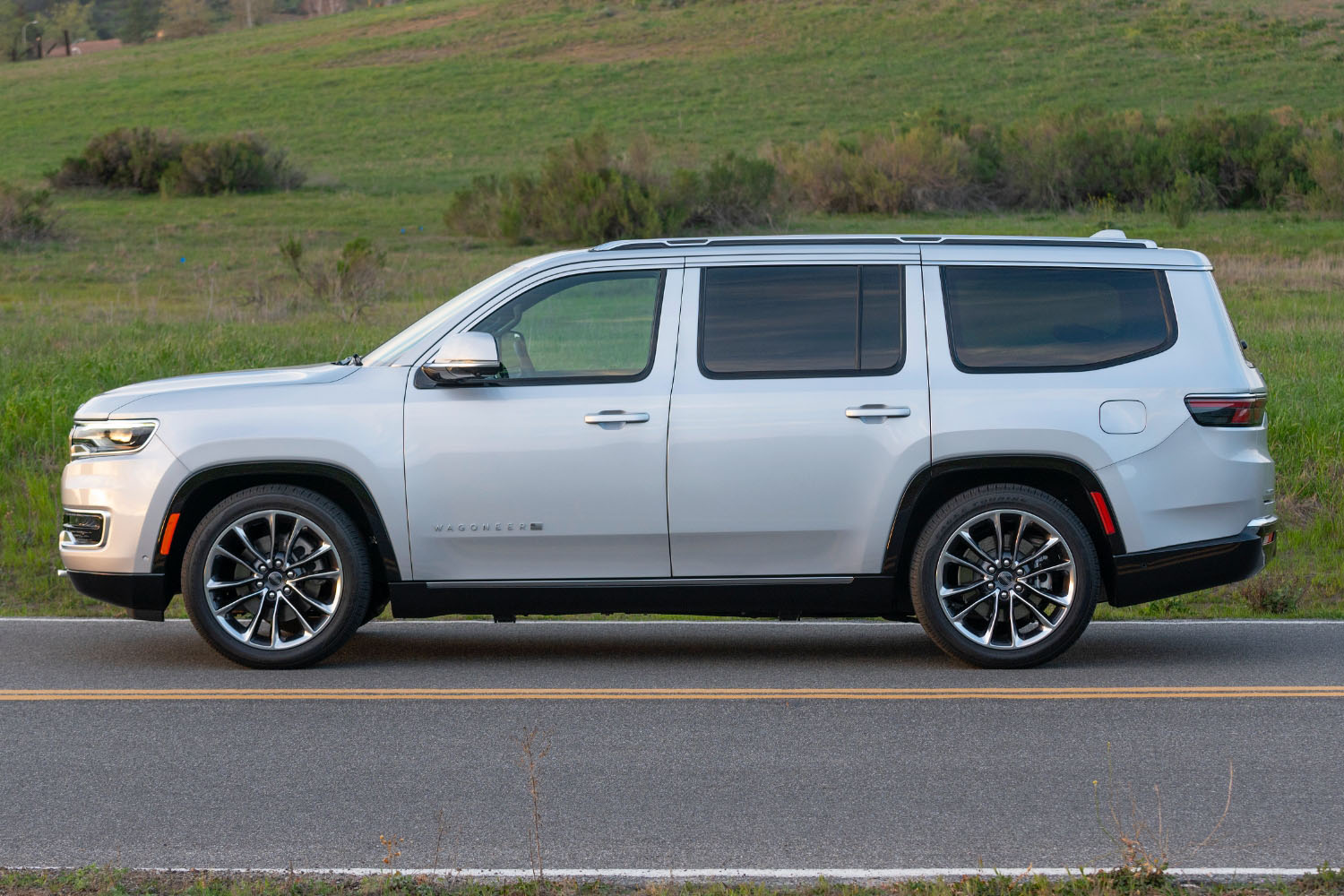 Michael Harley
Michael Harley
2022 Jeep Wagoneer Review: The Design
Jeep resisted the temptation to put fake wood paneling down the sides of the new Wagoneer, but it may have made the styling more distinctive and memorable. Overall, the Wagoneer shares the same basic shape as its competition, but Jeep did an excellent job ensuring the exterior has a premium appearance. Still, despite the attractive front styling, the sides and rear of the vehicle are rather bland and lacking in character.
Wood paneling might also immediately identify who makes the Wagoneer. The big SUV is emblazoned with “WAGONEER” lettering on all four sides, yet search the vehicle’s exterior, and there isn’t a single “JEEP” badge to be found. That was a deliberate move by the company, which insists the truck’s distinctive seven-slot grille, trapezoidal wheel arches, and rugged styling will tell everyone it’s a Jeep. That might be so, but a handful of people asked who made the Wagoneer during our week-long test drive.
Step into the Wagoneer’s cabin, and you will immediately notice the upscale interior, which is one way Jeep is competing with the GMC Yukon Denali and higher-trim versions of the Chevrolet Tahoe and Ford Expedition.
Premium leather upholstery with contrasting stitching covers the seating and armrests, while other touchpoints have high-quality, soft surfaces. For example, Jeep molds the dashboard from a single piece of synthetic material, and it feels great to the touch, while simulated stitching gives the impression that it is wrapped in natural leather.
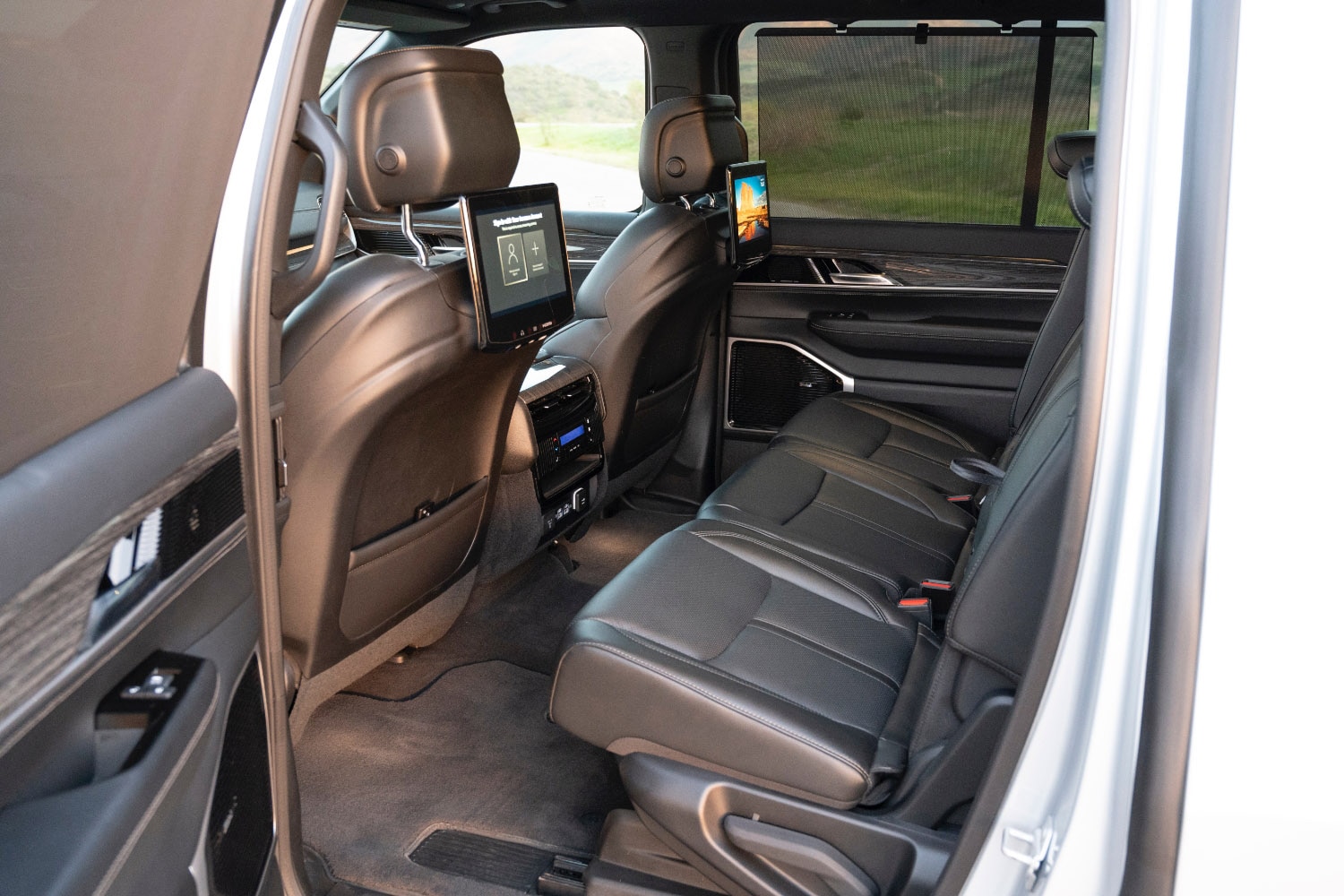 Michael Harley
Michael Harley
Contrast comes in the form of bright trim that runs horizontally across the dashboard, steering wheel, and climate control vents to lend a visual sense of width and expansiveness. Lastly, simulated wood adds a final touch of elegance. Overall, the interior is attractive and pleasing to the eye.
The basic layout of the controls is operator-friendly, and it takes little time to acclimate to nuances such as a rotary dial to control the transmission and audio control buttons on the back of the steering wheel. However, some of the Wagoneer’s climate controls can be confusing, especially to those unfamiliar with them.
For example, each front occupant has their own temperature adjustment located beneath the lower corner of the infotainment screen. The buttons feature blue and red chevrons to indicate which direction produces more heat or cooling. They appear to be rocker switches, so passengers press down on the red side to make it warmer. What happens instead is that they make it colder because the design is actually a piano-key-style switch that you push up for added heat and push down for added cooling.
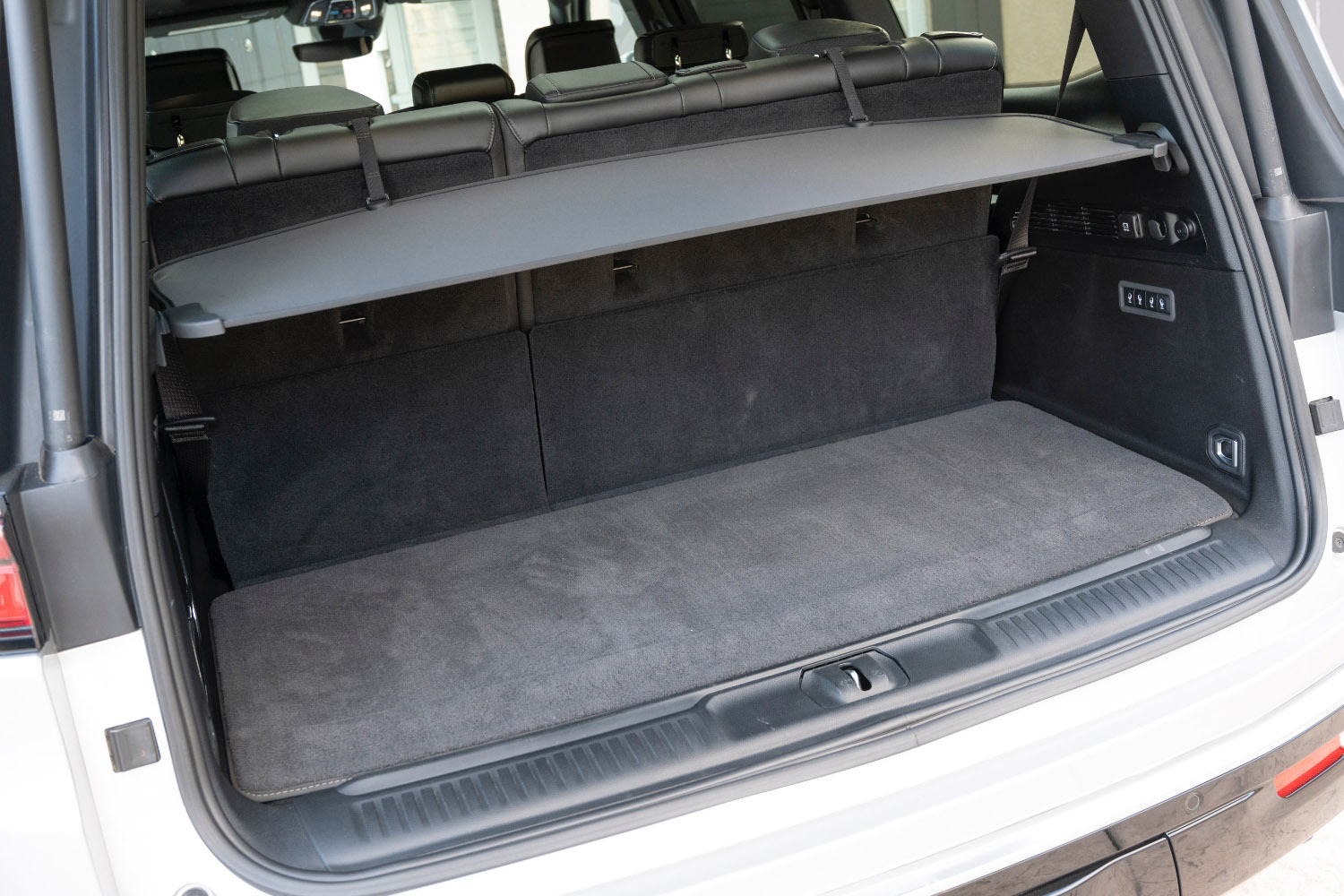 Michael Harley
Michael Harley
Up front, the driver and passenger enjoy spacious and comfortable seats that allow a commanding view of the road aided by oversized exterior mirrors that are incredibly helpful when maneuvering. The second-row captain’s chairs (which bring total seating capacity down to seven) are equally as generous in terms of passenger space, and the seating position is high so that occupants won’t feel claustrophobic.
In addition, the second row gets separate climate controls and an array of USB ports and power supply outlets to support every known digital device. A one-touch button eases access to the third row, which can actually accommodate adults. Third-row passengers also get air conditioning vents and an array of power ports, which is a nice touch.
Cabin utility is a strong point with storage nooks and pockets throughout the cabin. The rows of seats split and fold in various combinations, either manually or with electric motors, and there are additional power ports and sturdy metal tie-downs in the aft cargo area.
The power-activated tailgate button is located inside the cargo area, making it easier for shorter-statured people to reach. Cargo space measures 27.4 cubic feet behind the third-row seat, 70.8 cu-ft behind the second row, and 116.7 cu-ft behind the front seats with both rear rows folded down.
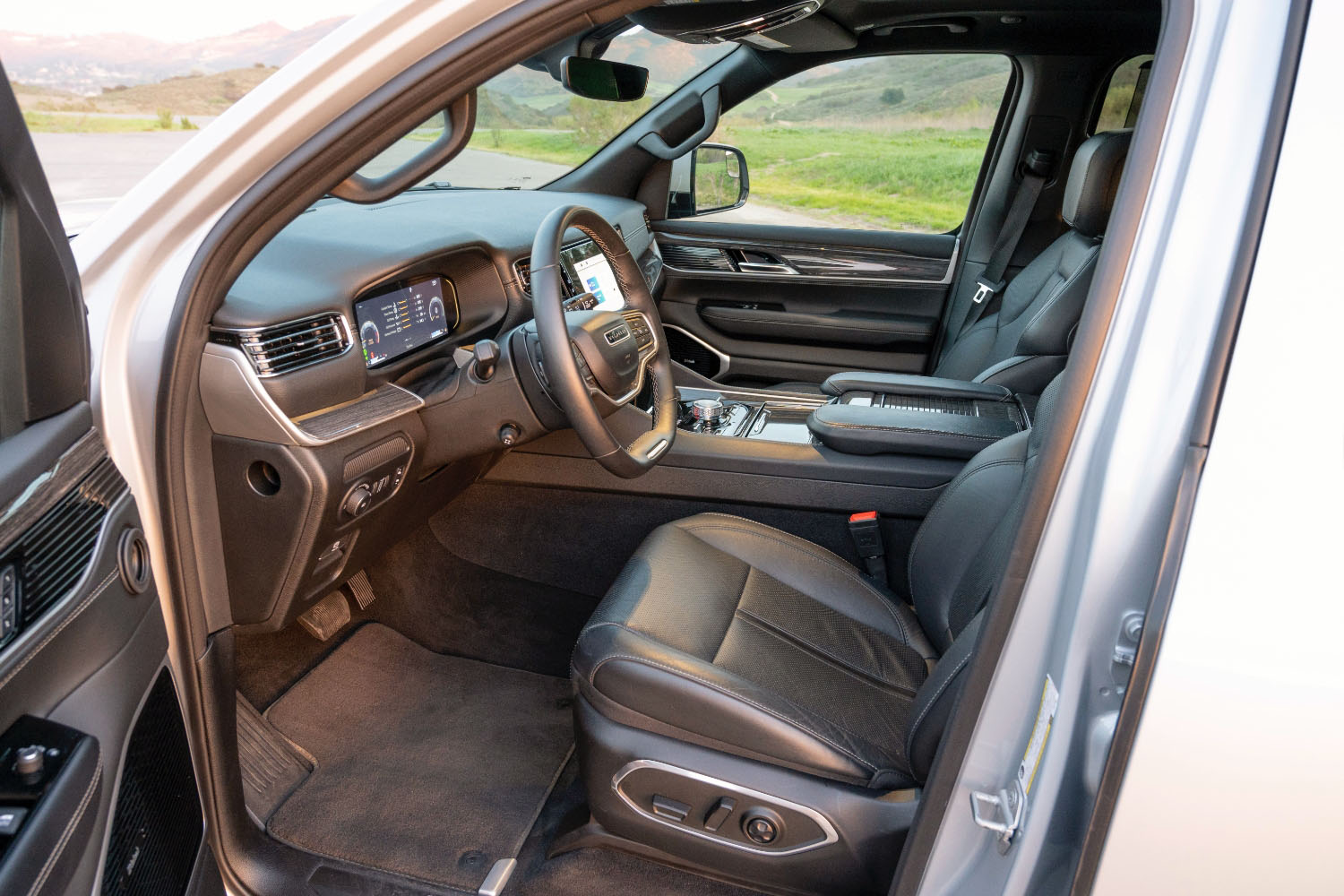 Michael Harley
Michael Harley
2022 Jeep Wagoneer Review: The Technology
Jeep loads the Wagoneer with technology that works well, yet sometimes overwhelms. Uconnect 5 is the current version of Jeep’s infotainment interface. It is innovative and brimming with capability, yet it’s not as user-friendly as previous versions of Uconnect that were more graphics-laden and intuitive. As such, it takes a bit of familiarizing before moving through the menus becomes second nature.
Every Wagoneer includes a 10.25-inch digital instrumentation display and a 10.1-inch infotainment touchscreen display. A second 10.25-inch display positioned directly in front of the passenger is optional, but was not installed in our test vehicle. The infotainment screen is well-placed and easy to reach, but many of the operating buttons located around the perimeter are backlit through a black plastic surface. Reflections and an odd angle make them a real challenge to read. This problem isn’t limited to the infotainment controls. For example, the worst offenders are the drive mode options placed on each side of the transmission dial.
The Wagoneer’s suite of technology is comprehensive. Highlights include wireless Apple CarPlay and Android Auto, an available 4G Wi-Fi Hotspot that supports up to eight devices simultaneously, and a mobile app that allows the operator to replicate most of the key’s functions (lock, unlock, start the engine, and more) from anywhere.
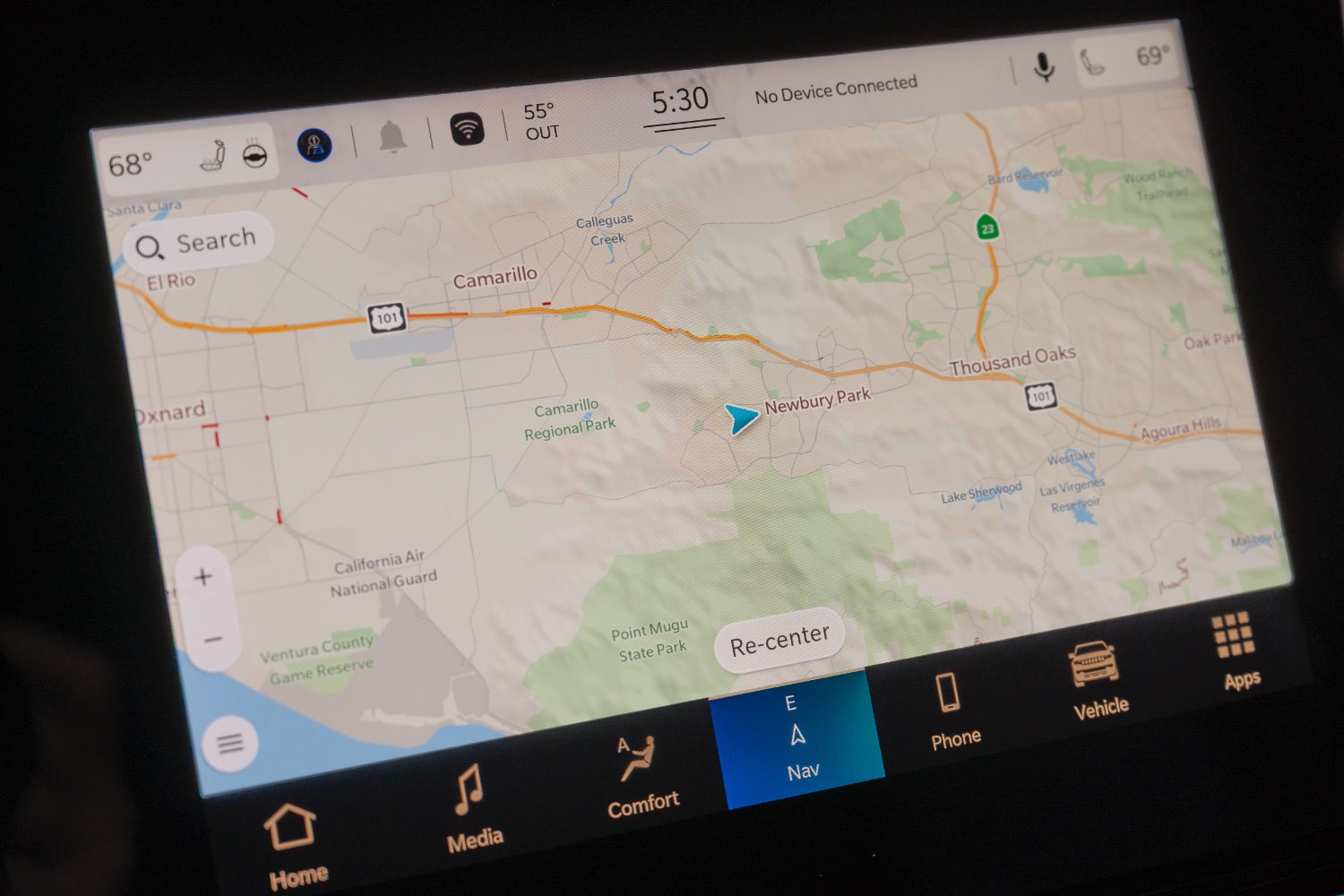 Michael Harley
Michael Harley
The app also provides Drive Alerts related to geographic boundaries, vehicle speed, and more, which is great for monitoring younger drivers. Additionally, owners may also use Alexa or Google to activate many features from inside their homes, and especially tech-savvy owners may even use their smartwatch.
Frankly, there are so many digital features incorporated into the Wagoneer that it’s likely owners may barely scratch the surface of the capabilities. That may also prove true regarding the Wagoneer’s state-of-the-art safety and driver assistance features.
Active Drive Assist is one of them, combining lane centering and adaptive cruise control for travel in both stop-and-go traffic and at highway speeds. In practice, the setup works well and with smooth precision. While it’s not a fully autonomous system and reminds the driver to keep their hands on the wheel, it does a great job of reducing the driver’s workload by keeping the vehicle centered within its lane while maintaining a safe distance behind traffic ahead.
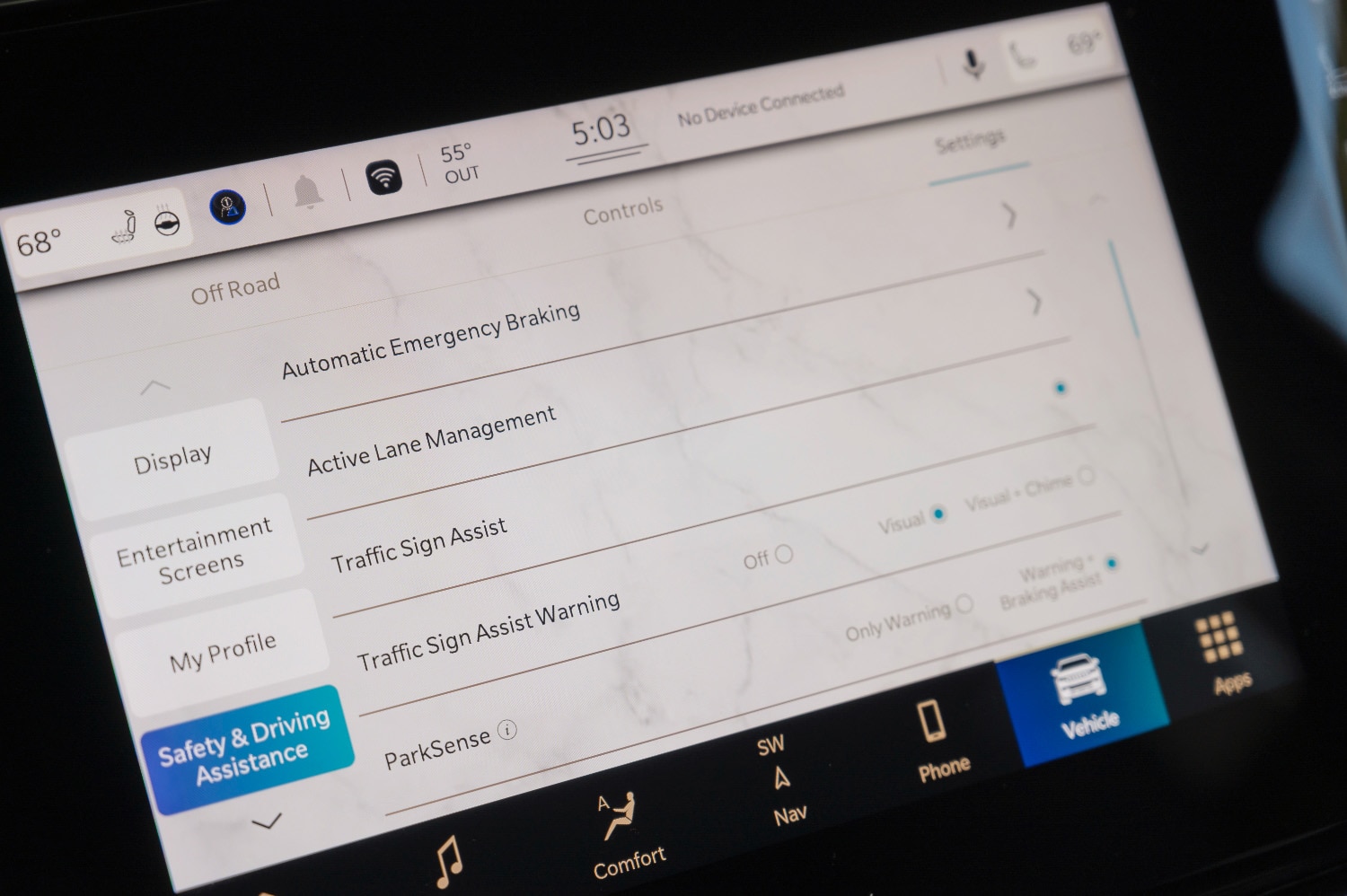 Michael Harley
Michael Harley
Additionally, Jeep offers an Intersection Collision Assist system for the Wagoneer. This optional technology uses cameras and sensors to anticipate potentially hazardous situations at intersections. It warns the driver of the threat and will apply the brakes if needed. Fortunately, I did not experience this technology during testing.
As this review is written, the 2022 Jeep Wagoneer has been crash-tested neither by the Insurance Institute for Highway Safety (IIHS) nor the National Highway Traffic Safety Administration (NHTSA).
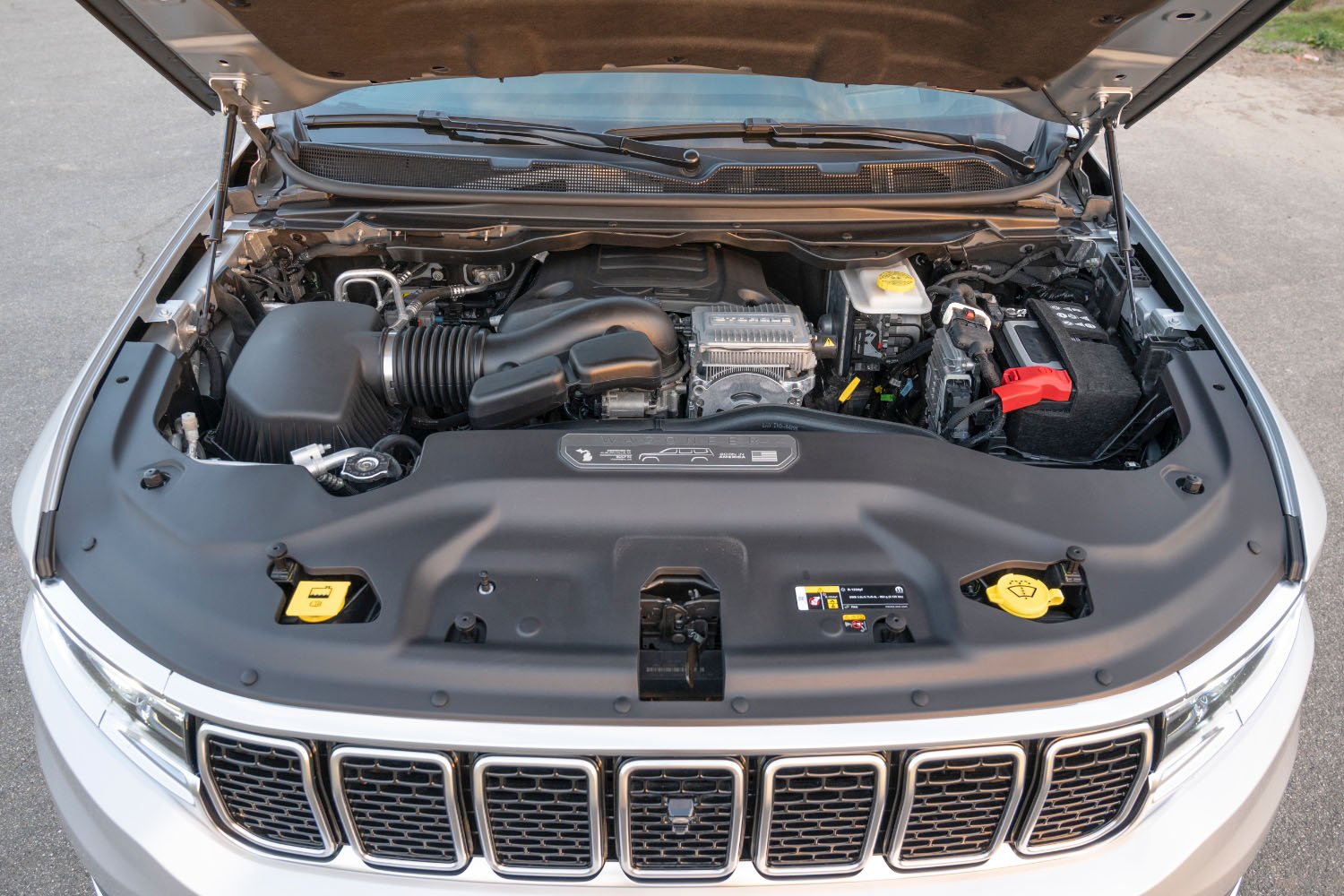 Michael Harley
Michael Harley
2022 Jeep Wagoneer Review: The Drive
As expected from an American automaker that prides itself on brawny engines, Jeep fits the Wagoneer with a thoroughly modern variant of its 5.7-liter V8. This V8 is one of its trusted engines that dates back nearly 20 years, and it develops 392 horsepower and 404 pound-feet of torque.
The engine mates to a standard eight-speed automatic transmission, regarded as one of the industry’s best. Jeep produces the transmission under license from German supplier ZF and markets it as the Torqueflite 8.
It’s important to note that the Wagoneer’s powertrain features Jeep’s eTorque 48-volt mild-hybrid technology. In a nutshell, a 48-volt battery stores energy through regeneration each time the vehicle decelerates. The energy is used to power the engine stop/start system, effectively making it nearly transparent in operation.
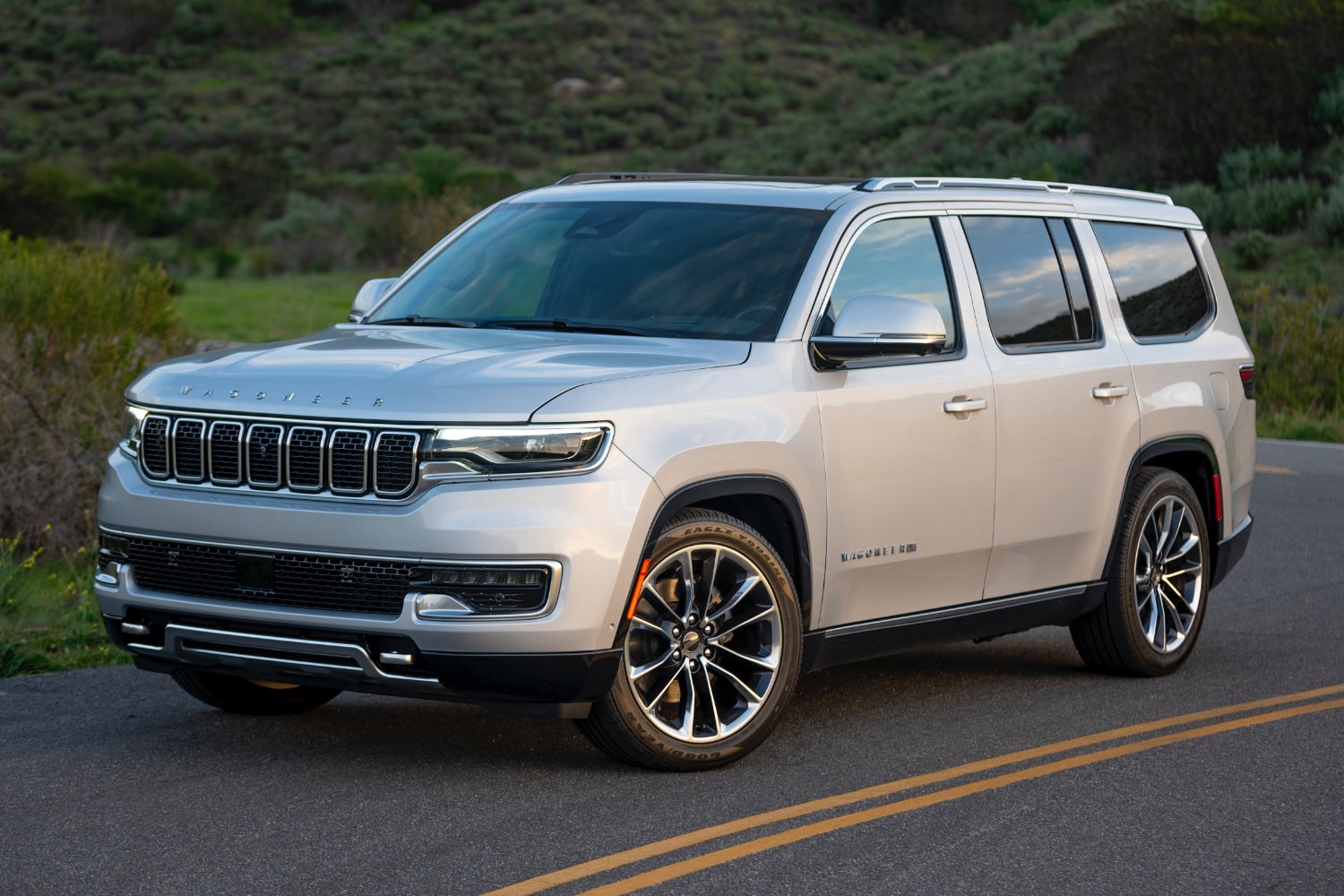 Michael Harley
Michael Harley
It also smoothes transmission shifts, powers the electrical accessories, and recharges the standard 12-volt battery. In addition, the eTorque system works behind the scenes, improving driving dynamics and fuel efficiency.
Acceleration feels strong, and the V8 emits an authoritative growl, but it’s not particularly quick when measured by a stopwatch. Expect the Wagoneer to complete the benchmark 0-60 mph sprint in about 7.5 seconds, a bit slower than the others within its competitive segment. On a positive note, the muscular V8 allows the Wagoneer to tow up to 10,000 pounds when properly equipped, which is a best-in-class rating.
Jeep bases the Wagoneer on the Ram 1500 pickup platform. The standard suspension uses coil springs, but an air suspension system with electronically controlled damping is available. Our test vehicle had it, and the ride proved smooth and comfortable on most surfaces, whether cruising city streets or zooming down the highway.
However, the ride worsens significantly on rough or broken roads. Blame the massive 22-inch wheel/tire package that is standard on the Series II and Series III trims. Even though the large wheels and low-profile tires improve steering response and handling, the increased unsprung weight transfers a lot of energy back through the suspension, which the driver feels as shudder.
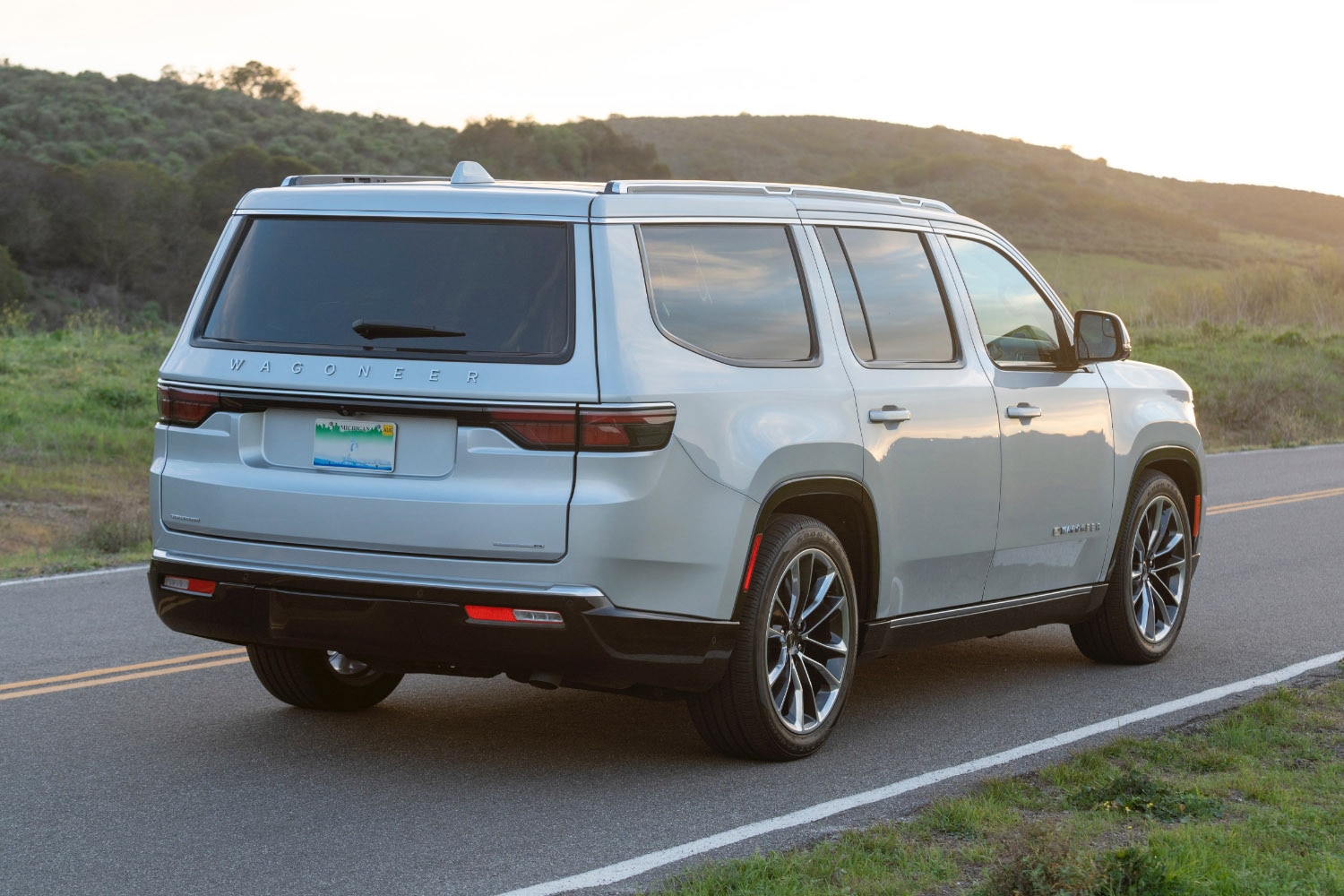 Michael Harley
Michael Harley
In addition, Jeep specifies a relatively high 40 psi tire pressure, primarily to protect the sidewalls and improve steering, yet that only worsens the issue as the tires resist impacts. The Wagoneer Series I’s standard 20-inch wheels undoubtedly give a better ride.
Aside from the occasionally rough ride, the Wagoneer’s driving dynamics are impressive. The steering is appropriately weighted, with a solid feel that matches the size and mass of the vehicle. Stability at speed is excellent, and the Jeep doesn’t lose its composure when driven with enthusiasm.
And, unlike most others in this segment, the brakes on the Wagoneer feel exceptionally strong. Initial application of the brake pedal results in immediate bite as the pads contact the rotors, and stopping speed is proportional to pedal effort.
Fuel economy isn’t a Jeep Wagoneer strong point. The Environmental Protection Agency (EPA) rates the 4WD Wagoneer at 17 mpg in combined driving. On our test drive loop, which is a good mix of steady-state highway, stop-and-go city traffic, and driving up and down canyons with an elevation change of about 1,500 feet, the Jeep delivered an indicated 16.5 mpg.
 Michael Harley
Michael Harley
Is the 2022 Jeep Wagoneer a Good SUV?
Jeep may be a bit late to the full-size, luxury SUV party with the new Wagoneer, but it can likely carve out a niche that serves a specific type of buyer—the traditional Jeep customer. These are owners who use their trucks not only as daily drivers, but also as workhorses to tow boats, campers, horses, and recreational toys from place to place, and they need capable 4WD systems, additional ground clearance, and plenty of utility.
The Wagoneer delivers all of these qualities—best-in-class in some instances—and adds innovative technology and lavishness. While it may not be the most luxurious and smoothest-riding model in its segment, it’s the only full-size SUV capable of genuinely legitimizing the Jeep nameplate, aside from the downright luxurious Jeep Grand Wagoneer, of course.
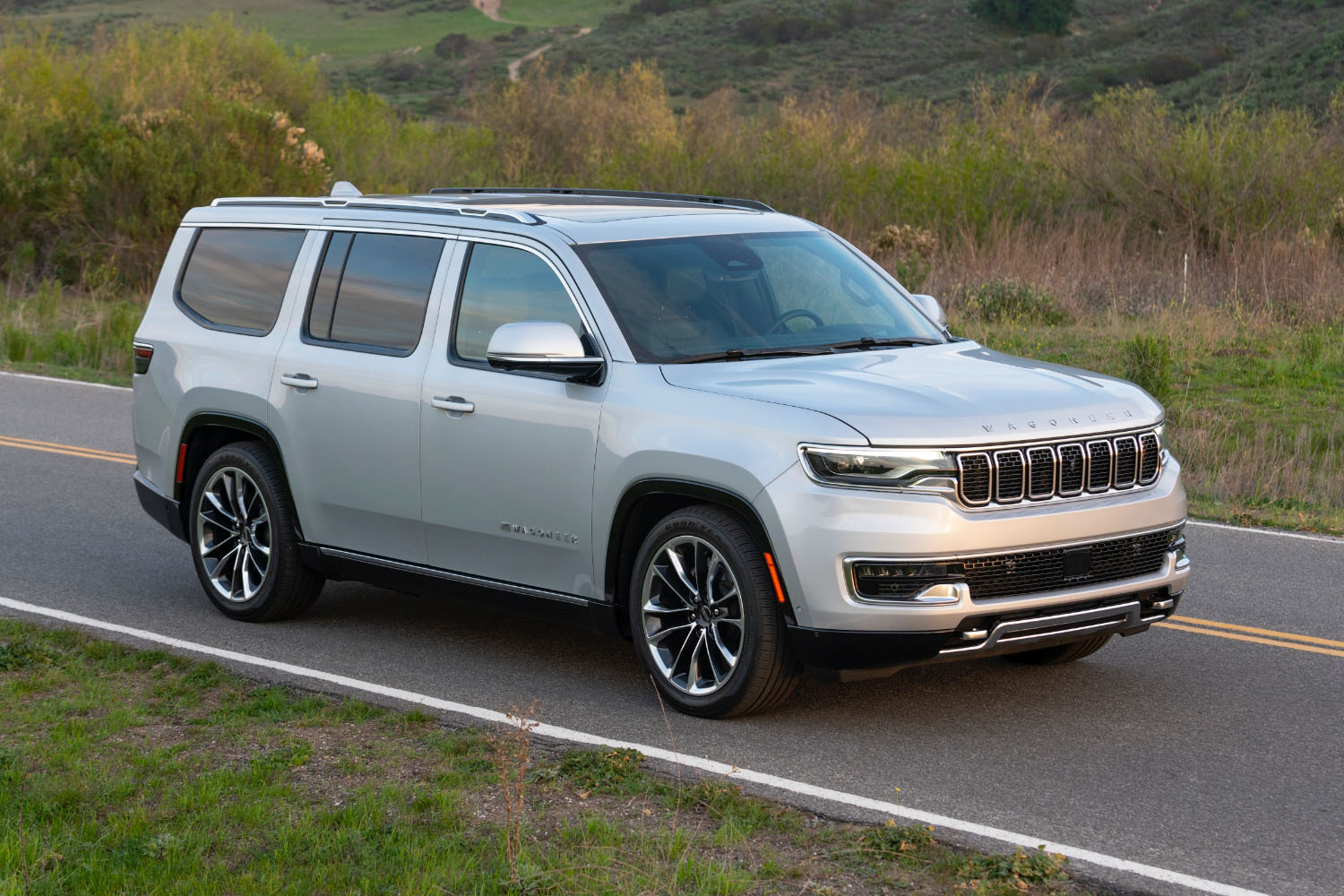 Michael Harley
Michael Harley
Written by humans.
Edited by humans.
 Michael Harley
Michael HarleyI’m one of the lucky few who have been able to turn my passion for automobiles into a professional career. On that note, I’ve written reviews for the industry’s top outlets, been quoted about events and trends by the leading business publications, and appeared on national television discussing new vehicles and safety. As a bona fide “car guy,” I jump at the opportunity to climb behind the wheel of every new car, truck, and SUV — and communicate to others about the experience.
Related articles
View more related articles